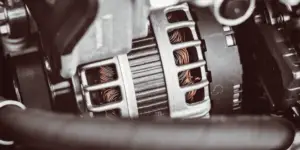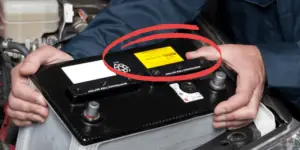Most people know the alternator powers all electrical components when the car is being driven and also charges the battery.
What about the diodes inside the alternator? What do they do?
This article will explore what a diode does, why they’re important, and what to look out for if you feel it may be failing.
Automotive alternators have six diodes positioned inside them. They are not visible from the outside as they are encased in metal in the rectifying assembly.
The alternator generates power using an alternator belt which leaves the engine and snakes its way through the engine bay.
As it does so, it spins the alternator at the same speed the engine is revving at. This creates power and an electrical current within the alternator.
Here’s the problem
The power is AC, whereas the car must run on DC. If AC were used throughout the car, it would cause electrical components to fail very quickly and damage the battery.
This is where diodes come in.
The job of a diode is to turn the AC created by the alternator into DC. This process is called a rectification; hence the diodes sit in the rectifier assembly as mentioned above.
An alternating current would be bad for a car’s electrical system as the voltage would vary along with the direction of travel of the current.
As the cars’ electrical systems need consistency and rely on power being sent one way, this would not work.
This is what diodes do.
The rectifying bridge containing the diodes takes the negative current from the AC, passes it to the ground through the grounding strap, and passes the positive current to the rectifying bridge, converted into direct current.
Therefore the diodes perform extremely important functions within the alternator.
Diodes and voltage regulators are often confused.
The voltage regulator inside the alternator controls how much voltage leaves the alternator to all electrical components. The diode controls the flow of the discharge.
Overtime diodes do fail. If one or two fail out of the six, the car can still maintain decent electrical output in normal working conditions.
However, in extreme heat or cold periods when more power is required from the alternator, you may notice some of your systems not working as you expect them to.
In hot weather, the air-con may not work as well as it should, and in cold conditions, the heated screens, seats, and blower may not do their job.
What Do Alternator Diodes Look Like?
Unless you open up the alternator, you’ll never actually see the diodes within it. As mentioned, they sit in the rectifying bridge.
Some alternators have one rectifying bridge containing six diodes. Others split it and have two bridges with three diodes, each inside.

Alternator diodes have what seems to be a pin protruding from a circular housing. A bit like a Sputnik if you are of a certain vintage!
Can You Upgrade Diodes in The Alternator?
Diode modifications are becoming more popular amongst people requiring more electrical output for the alternators. But you need to know what you’re doing to attempt this.
Generally, you are adding a diode to the B-side of the regulator to fool it into thinking that the B+ voltage is lower than it is.
The consequences are that the system will allow more output voltage through the voltage regulator, allowing more power on tap for all electrical components.
This is a really popular mod for people who drive in extreme weather conditions, whether hot or cold, or have extensive sound systems that require additional power to run and increase volume through speakers.
This modification certainly reduces the cost of buying a high output alternator that can run hundreds of dollars more than a standard alternator would cost.












